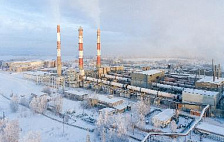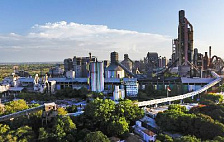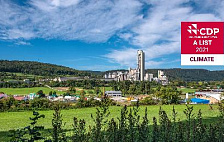Kazakhstan’s cement sector considers 2021 a record year. Production of this major building material is rapidly growing in the country due to intensive construction activity and stable export opportunities. Thus, according to the 2021 results, the country’s cement plants produced 12.65 Mt of cement exceeding the 2020figures by more than 15 per cent. Actually the cement sector established a historical production record in the 31 years of the Republic of Kazakhstan’s (RK) independence. Since 2014 the construction volumes and, in line with it, cement output on the average grows 6 % and 7 % a year respectively.
The plans of the Ministry of Infrastructural Development (MID) for the coming four years (2021-2025) are grandiose: they call for the construction of 103 million sq. m. of floor space in new housing, which means that each year it would be necessary to construct a third more floor space than in 2019. And this in turn means that the demand for cement should also grow annually by one third.
According to Erbol Akymbaev, Executive Director of the Kazakhstan Association of Cement and Concrete Producers, the high market demand gave an impulse to output growth at Kazakhstan’s cement plants. The plants currently in operation, for example Kokshe-Cement, have substantially increased the output, while the new ones, as for instance ALACEM, have virtually reached their design capacity.
In view of the growing market the Singapore holding International Cement Group, co-owner of the ALACEM plant, decided to expand its presence in the country. In 2021 the holding paid $16.6 mln to acquire the assets of the Kazakh-Cement plant in Eastern Kazakhstan oblast that had been mothballed for several years and also announced its plans to build one more cement plant in Zhambyl oblast within the next two years (the estimated cost of that project is $150 mln).
Considering that the total capacity of all the 15 Kazakhstan cement plants is 17 Mta and their average capacity utilization factor of 60-70 % (MID data) their total output would suffice to satisfy the demand of the growing construction market. Thus, in the next one or two years the RK cement production capacity can increase to 19 Mt owing to the commissioning of the new cement plants currently under construction.
Problem with gas emissions
However from this year on some plants might already find it hard to operate at full capacity. This is all about the announced reduction of the permissible level of carbon dioxide emissions. Carbon dioxide (CO2) is a natural product of cement manufacture as it is released at limestone (СаСО3) roasting, limestone being the basic raw material in cement production. At the same time, within the framework of the Paris agreement, Kazakhstan has committed itself to reducing all carbon emissions by 15 % by 2030 from the 1990 level, and for this purpose has been regularly cutting the free carbon quotas (i.e. the maximum permissible CO2 volume which is emitted by the polluting factories in the course of manufacture) each year. Those who fail to meet the allocated quotas must get carbon units in the market or pay the penalty (5 MNU (monthly notional units) or about $35 per tonne of СО2). If, until 2020, there had been enough distributed quotas for everybody, now many cement producers are already unable to meet the ever diminishing norms.
It is possible to buy quotas at emission trading exchanges, the sellers being the companies that have alternative (renewable) energy sources (RES) or modern equipment that makes it possible to lower the level of СО2 emission. According to Erik Tanaev, president of CCX (Caspiy Commodity Exchange), now carbon units are mostly sold by oil companies. «At the beginning of the year potential participants need to calculate their emissions, and by August, in case of shortage, get quotas. We can already observe activity among potential buyers», says Erik Tanaev.
In 2022 the RK government intends to reduce the number of free quotas for CO2 emission by more than 10 % - from 169.2 million to 151.8 million units, and by 2025 - by 26 %. Provision for these changes is made in the draft national plan for distribution of carbon emission quotas for 2022-2025 developed by the RK Ministry of Ecology, Geology and Natural Resources (MEGNR).
For the country’s cement sector it means that, within the limits of such quotas, in 2022 cement plants will be allowed to put out less than half (9 Mt) of the country’s total production capacity (17 Mt), while by 2025 this figure will go down to 38 % (7.3 Mt).
In 2018-2020, because of very few transactions on the exchange, the cost of the quotas remained low. According to Erik Tanaev, the prices of the deals struck on the exchange varied within the 400 to 560 tenge range per tonne of CO2. But the envisaged reduction of the quotas will produce a shortage and, as predicted by representatives of the market, with high probability inflate the price for carbon units at the auctions.
«The purchase expenses for CO2 quotas are an irrevocable loss for the company as they cannot be included in the product cost. But the most complicated problem is the impossibility to anticipate additional outlays for the acquisition of future additional CO2 quotas as there is no transparent methodology for calculating next years’ quotas, and it is also not known what the СО2 price will be in Kazakhstan. In the conditions of complete uncertainty it is difficult for businesses to plan the development and investments for further growth» was the comment by Pyotr Durnev, CEO of Central Asia Cement Company.
«Considering the current decarbonisation drive and the goals set at the last summit in Glasgow, the participants of the quotas market will be more active, and, accordingly, one should expect higher prices», Tanaev continues. The market of the Western countries has already shown that the price of carbon units in Kazakhstan can grow more than tenfold – from the current $1.1 to $35-50 per tonne of CO2.
«In Europe the price of a carbon unit is slightly below the penalty for exceeding the norms of CO2 emission. That is, in our case it would be the penalty of 5 MNU (3063*5 = 15,315 tenge in 2022) minus, conditionally, 5 % resulting in about 15,000 tenge per tonne of carbon in 2022. By 2025, judging by the Road Map, it will be at least $50», predicts Erbol Akymbaev.
In January 2022 one cold already see sale offers for analogues of carbon units in the Kazakhstan market at the price of 7.5 thousand tenge, that is 15 times higher than in the previous year.
Green Income reports on the presence of an offer for sale of offset units (analogue of the carbon unit without restriction on the period of validity) with a starting price of 7.5 thousand tenge per unit (1 offset unit = 1 tonne of СО2). The company (among its activities are transactions with securities) promoting this sale states that the acquisition of offset units is an investment and a guarantee against price jumps in the market of carbon units.
According to EY, these changes, can lead to growth in the cost price of emitters’ end products. Representatives of the branch confirm these forecasts.
«Considering the envisaged sharp decrease in the number of quotas and the market price growth of СО2 in RK, by analogy with Europe, Kazakhstan producers will be forced to include the cost of СО2 in the product price. It is obvious that the СО2 price growth will negatively affect the competitiveness of the Kazakhstan industry as a whole» says Vitaly Pavlov, sales manager of HeidelbergCement Kazakhstan.
Erbol Akymbaev provides an example of how the expense of purchasing the carbon units may grow for cement plants. They may grow from the current 20-60 mln tenge (0.2-0.4 % of the company turnover) to 600 mln – 1.8 bln tenge (6-12 % from a turn) in 2022, and by 2025 - to 800 million – 2.6 млрд tenge (9-17 % of the company turnover).
But first of all the rise in CO2 prices will hit the main buyer of carbon units - the power sector of Kazakhstan which is mainly represented by coal power stations, and ultimately result in the hike of the electric power prices.
«We expect that in 2022, due to a shortage of CO2 quotas, the electric power prices might grow by 15 %» says Akymbaev. This will also entail a rise in cement prices, as the electric power share in its cost price, depending on the cement plant and the production technology used, amounts to an impressive 15-25 %.
Akymbaev is perplexed saying: «On the one hand we see a rise in the СО2 prices, and on the other - a rise in the electric power prices. At the same time, quotations on the stock exchange can change every second, and so it is impossible to predict price changes and make proper production plans - it is some kind of roulette. The foreign investors who have invested billions in the Kazakhstan plants start having doubts about the viability of manufacture under the limits of such regulation».
Erbol Akymbaev is sure that such growth of the cost price for domestic cement against the increased demand from the construction market will inevitably increase the share of cement imports and lead to bankruptcy of some domestic cement producers. He predicts that, since the amount of СО2 set for the cement sector in 2022 is limited to 7.2 Mt, within the framework of these quotas this will allow producing only 9 Mt of cement while the domestic consumption in Kazakhstan amounts to 11.5 Mt. This difference will have to be supplied by importers - first of all by Uzbekistan with its increased cement producing capacity and Russia, that is the countries where there are no carbon regulations. This will start the process of shutdowns of Kazakhstan’s plants.
According to cement industry players, such market conditions can be adjusted by introducing a carbon tax on the imported commodities that are already produced in the country. This will be done by analogy with the solution of the European Union which from 2023 is introducing the carbon correcting boundary mechanism», an analogue of the import duty which is linked to the carbon intensity of products.
«We are not against the global warming control, - say cement industry representatives, - but the government’s ecology policy should be transparent and coherent».
Commenting on the provisions of the National Plan of Carbon Quotas for 2022-2025 displayed on the Open Government website the market players complain that it lacks transparency in its calculations for distribution of quotas.
Erbol Akymbaev agrees with his colleagues when they say that, when defining the quota norms, nobody consulted them and nobody could explain the calculations - why there were such figures. Revising the coefficients within the methodology and increasing the quotas for cement industry even by as little as 1 % will enable the producers to feel more confident and supply the market with an amount of domestic cement sufficient for all construction projects in Kazakhstan.
Besides increasing the quotas the cement sector proposes additional solutions for reducing the carbon footprint by building waste processing plants instead of waste incinerators in Kazakhstan.
Akymbaev concludes by saying: «The share of coal burnt in the course of cement manufacture can be reduced by replacing it with solid domestic waste. For this purpose the waste need not to be buried in landfills by sorted out, dried, ground and packed into briquettes at waste processing plants. Waste incinerators offer to burn waste for 175 tenge per kWh. We are ready to do it free of charge».








